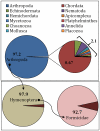Metatranscriptomics and pyrosequencing facilitate discovery of potential viral natural enemies of the invasive Caribbean crazy ant, Nylanderia pubens
- PMID: 22384082
- PMCID: PMC3288052
- DOI: 10.1371/journal.pone.0031828
Metatranscriptomics and pyrosequencing facilitate discovery of potential viral natural enemies of the invasive Caribbean crazy ant, Nylanderia pubens
Abstract
Background: Nylanderia pubens (Forel) is an invasive ant species that in recent years has developed into a serious nuisance problem in the Caribbean and United States. A rapidly expanding range, explosive localized population growth, and control difficulties have elevated this ant to pest status. Professional entomologists and the pest control industry in the United States are urgently trying to understand its biology and develop effective control methods. Currently, no known biological-based control agents are available for use in controlling N. pubens.
Methodology and principal findings: Metagenomics and pyrosequencing techniques were employed to examine the transcriptome of field-collected N. pubens colonies in an effort to identify virus infections with potential to serve as control agents against this pest ant. Pyrosequencing (454-platform) of a non-normalized N. pubens expression library generated 1,306,177 raw sequence reads comprising 450 Mbp. Assembly resulted in generation of 59,017 non-redundant sequences, including 27,348 contigs and 31,669 singlets. BLAST analysis of these non-redundant sequences identified 51 of potential viral origin. Additional analyses winnowed this list of potential viruses to three that appear to replicate in N. pubens.
Conclusions: Pyrosequencing the transcriptome of field-collected samples of N. pubens has identified at least three sequences that are likely of viral origin and, in which, N. pubens serves as host. In addition, the N. pubens transcriptome provides a genetic resource for the scientific community which is especially important at this early stage of developing a knowledgebase for this new pest.
Conflict of interest statement
Figures




Similar articles
-
Non-enzymatic hydrolysis of RNA in workers of the ant Nylanderia pubens.J Insect Sci. 2012;12:146. doi: 10.1673/031.012.14601. J Insect Sci. 2012. PMID: 23461820 Free PMC article.
-
Pyrosequencing the Bemisia tabaci transcriptome reveals a highly diverse bacterial community and a robust system for insecticide resistance.PLoS One. 2012;7(4):e35181. doi: 10.1371/journal.pone.0035181. Epub 2012 Apr 30. PLoS One. 2012. PMID: 22558125 Free PMC article.
-
Wolbachia Infection in Native Populations of the Invasive Tawny Crazy Ant Nylanderia fulva.Front Insect Sci. 2022 Jun 6;2:905803. doi: 10.3389/finsc.2022.905803. eCollection 2022. Front Insect Sci. 2022. PMID: 38468766 Free PMC article.
-
Complete chromosome-level genome assembly data from the tawny crazy ant, Nylanderia fulva (Mayr) (Hymenoptera: Formicidae).Data Brief. 2022 Dec 16;46:108833. doi: 10.1016/j.dib.2022.108833. eCollection 2023 Feb. Data Brief. 2022. PMID: 36591376 Free PMC article.
-
A Review of the Tawny Crazy Ant, Nylanderia fulva, an Emergent Ant Invader in the Southern United States: Is Biological Control a Feasible Management Option?Insects. 2016 Dec 15;7(4):77. doi: 10.3390/insects7040077. Insects. 2016. PMID: 27983690 Free PMC article. Review.
Cited by
-
Evolutionary history of the Azteca-like mariner transposons and their host ants.Naturwissenschaften. 2015 Aug;102(7-8):44. doi: 10.1007/s00114-015-1294-3. Epub 2015 Jul 21. Naturwissenschaften. 2015. PMID: 26195134
-
Single-stranded RNA viruses infecting the invasive Argentine ant, Linepithema humile.Sci Rep. 2017 Jun 12;7(1):3304. doi: 10.1038/s41598-017-03508-z. Sci Rep. 2017. PMID: 28607437 Free PMC article.
-
The nuclear and mitochondrial genomes of Frieseomelitta varia - a highly eusocial stingless bee (Meliponini) with a permanently sterile worker caste.BMC Genomics. 2020 Jun 3;21(1):386. doi: 10.1186/s12864-020-06784-8. BMC Genomics. 2020. PMID: 32493270 Free PMC article.
-
Meta-Omics Tools in the World of Insect-Microorganism Interactions.Biology (Basel). 2018 Nov 27;7(4):50. doi: 10.3390/biology7040050. Biology (Basel). 2018. PMID: 30486337 Free PMC article. Review.
-
Isolation and characterization of Nylanderia fulva virus 1, a positive-sense, single-stranded RNA virus infecting the tawny crazy ant, Nylanderia fulva.Virology. 2016 Sep;496:244-254. doi: 10.1016/j.virol.2016.06.014. Epub 2016 Jun 30. Virology. 2016. PMID: 27372180 Free PMC article.
References
-
- Handelsman J, Rondon MR, Brady SF, Clardy J, Goodman RM. Molecular biological access to the chemistry of unknown soil microbes: a new frontier for natural products. Chem Biol. 1998;5:R245–R249. - PubMed
-
- Oi DH, Valles SM. Fire ant control with entomopathogens in the USA. In: Hajek AE, Glare TR, O'Callaghan M, editors. Use of microbes for control and eradication of invasive arthropods. New York: Springer Science; 2009. pp. 237–258.
-
- Tanada Y, Kaya HK. Insect Pathology. San Diego: Academic Press; 1993. 666
-
- Valles SM, Hashimoto Y. Isolation and characterization of Solenopsis invicta virus 3, a new postive-strand RNA virus infecting the red imported fire ant, Solenopsis invicta. Virology. 2009;388:354–361. - PubMed
-
- Valles SM, Strong CA, Dang PM, Hunter WB, Pereira RM, et al. A picorna-like virus from the red imported fire ant, Solenopsis invicta: initial discovery, genome sequence, and characterization. Virology. 2004;328:151–157. - PubMed
Publication types
MeSH terms
Substances
LinkOut - more resources
Full Text Sources
Other Literature Sources
Research Materials
Miscellaneous

